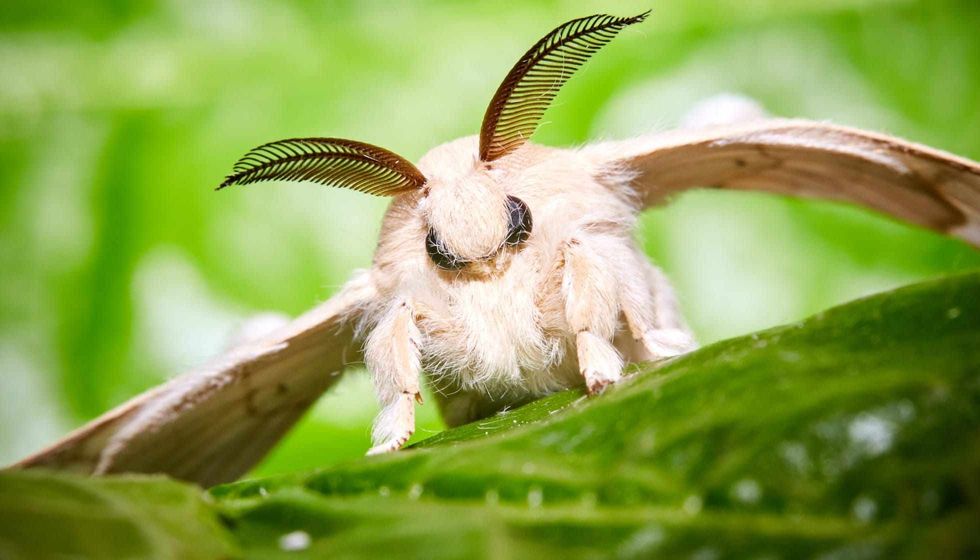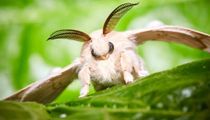The family Bombycidae encompasses primarily moths. Bombyx mori and Bombyx mandarina are the two most notable species of the Bombycidae family.
This is why the Bombyx mori (the domestic silk moth) and the Bombyx mandarina (the wild silk moth) are closely related. However, both species have their distinctive properties, for example, silk from the domestic silk moth is easier to process than silk from the wild silk moth.
The Bombyx mori have major economic importance because of the production of silk but silk production is dependent on humans because of selective breeding. The practice of rearing silk thread from domesticated silkworm moths to obtain raw silk is called sericulture.
This practice of rearing silkworms has a history that goes at least 5000 years back.
It started in northern China and gradually spread across the continent to countries like India, Nepal, Japan, Korea, and others. According to history, the tools that enable the production of silk did not develop before the Neolithic era.
Domesticated silk moths have lost their skill to fly because of selective breeding. This is a major difference between the Bombyx mori and other species of the Bombyx genus.
If you want to learn more about these amazing domesticated silk moths and how they are economically important then keep reading, because more interesting facts are mentioned in this.
If you like this article then check our other articles on genista broom moth and gypsy moth and share them with everyone.
Domestic Silk Moth Interesting Facts
What type of animal is a domestic silk moth?
The Bombyx mori or domestic silk moth as the name suggests is a type of moth that produces raw silk and is in high demand in the silk industry all over the world.
What class of animal does a domestic silk moth belong to?
The Bombyx mori moth belongs to the family Bombycidae that contains all species of moth including the wild silk moth.
How many domestic silk moths are there in the world?
It is hard to estimate the total number of Bombyx mori present in the world because they are being reared in huge amounts to produce silk. There are three major types of Bombyx mori. These are the univoltine, bivoltine, and polyvoltine based on their geographic range.
Where does a domestic silk moth live?
The history of the Bombyx mori has its root in China. China domesticated silkworms started producing silk about 5000 years ago. Later, this moth spread to other countries like India, Korea, Japan, Nepal, and even to the West.
Univoltine mulberry silkworms are primarily produced within the territories of greater Europe. Bivoltine mulberry silkworms are mainly produced in China, Korea, and Japan, while Polyvoltine mulberry silkworms are produced in the remaining areas across the tropics. The domestic silkmoth distribution affects the type of silkworm produced.
What is a domestic silk moth's habitat?
Bombyx mori, unlike the wild silk moth, is not found in the wild. They enable silk production so they are domesticated and raised. The domestic silk moth habitat is man-made where this moth gets an ample amount of mulberry leaves to eat.
Who do domestic silk moths live with?
These silkworms are being domesticated in large amounts for silk production and are cultivated together.
How long does a domestic silk moth live?
The process of becoming a moth from eggs can be very fascinating. The lifespan of the domestic silk moth is approximately four to six weeks. However, for the production of silk, when the silkworms reach their pupating stage they are killed and do not complete their lifespan.
How do they reproduce?
Due to selective breeding, domestic silk moths have lost their capacity to fly, making them dependent on humans to find a mate for reproduction. The process of reproduction is copulation.
After copulating successfully that may last for several hours, the female lays her eggs on the mulberry leaves. The female produces around 300-500 eggs. The eggs go through several phases until it ultimately metamorphosizes into a moth.
What is their conservation status?
The conservation status of these moths is Not Evaluated by the International Union for Conservation of Nature.
Domestic Silk Moth Fun Facts
What do domestic silk moths look like?
The Bombyx mori is almost 2-3 in (5-7.6 cm). It is buff-colored and has brown marking on the thoracic region. The pigment of these insects is lost now, unlike the imperial moth. These moths are not very colorful. After metamorphosis, their wingspan is approximately 1.5 in (3.8 cm).
How cute are they?
Domestic silkworms are harmless creatures and people keep them as a pet. However, many will not agree with this notion because they may be scared of insects or worms.
How do they communicate?
Domestic silk moths are comparatively social. The female releases a pheromone which attracts the male and the male does a flutter dance. This initiates the process of mating.
How big is a domestic silk moth?
The domestic silk moth size is approximately 2-3 in (5-7.6 cm). Its size is almost the same as American dagger moths which are 2-2.5 in (5-6.3 cm).
How fast can domestic silk moths move?
Domestic silk moths cannot fly anymore. The exact speed of these silkworms is not listed.
How much does a domestic silk moth weigh?
The weight of domestic silk moths is not evaluated. However, they grow 9000-10,000 times more during the last phases of the larval stage.
What are the male and female names of the species?
There are no special names that have been assigned to the male and female moths of this species.
What would you call a baby domestic silk moth?
There is no name particularly assigned to the offspring of this species. Before their metamorphosis, these silkworms are called larvae just like the larvae of other species like the rosy maple moth and puss moth.
What do they eat?
Mulberry leaves are the staple diet of domesticated silkworms. They thrive on mulberry leaves as larvae and gain weight. When these silkworms become moths after metamorphosis, the mouth region is reduced and they cannot eat anymore.
Are they harmful?
Silkworms do not cause any possible harm to humans. They are consumed as food in various parts of the world including China, Vietnam, and Assam in India.
Would they make a good pet?
These silkworms are raised and cultivated in a man-made habitat, unlike the wild silkworm. Other than the silk industries, people frequently keep silkworms as a pet.
They require mulberry leaves to thrive. However, silkworms are prone to various diseases such as fungus, like Beauveria bassiana, which can annihilate the entire body of silkworms. Parasites like Nosema bombycis can affect the growth of silkworms because this parasite kills all silkworms that are hatched from infected eggs.
Silkworms that are infected by Flacherie seem very weak and eventually die. Even though they have a short lifespan and low maintenance, taking care of them is essential.
Did you know...
The genome of the silkmoth was published in 2008.
To produce 12 lb (5.4 kg) of raw silk, it takes about 30,000 silkworms.
Do domestic silk moths bite?
The larva has a mouth but there are no incidents of them biting. Once the metamorphosis is complete. the mouth area of the moth is reduced and there is no chance of them biting.
What is the domestic silk moths life cycle?
The life cycle of these domesticated silk moths is relatively elaborate and is divided into distinctive phases. Female moths lay around 200-500 eggs on the mulberry leaves after copulation.
The female dies within two weeks after laying eggs. In the first stage, the eggs remain pale yellow for a few days and later change to purple or brown as they fertilize which takes about one week. The second stage is the larval stage where the eggs are hatched after 10-14 days.
The first instar larva is blackish and small. At an ideal temperature, the moth can grow up to 3 in (7.6 cm) length at a span of 25-30 days.
Meanwhile, the larva sheds its skin four times and gains weight. The silkworm goes through five stages of larva before moving to the next step when it is ready to pupate.
The larva survives on mulberry leaves before pupating. The third stage is pupation. These silkworms stop eating and form silkworm cocoons, from the cocoon commercial silk thread is obtained.
Pupating the body causes various changes including hardening of their exoskeleton and their bodies also shrink. It takes about four metamorphoses after which it emerges as a moth.
Here at Kidadl, we have carefully created lots of interesting family-friendly animal facts for everyone to discover! For more relatable content, check out these plume moth facts and luna moth facts for kids.
You can even occupy yourself at home by coloring in one of our free printable hawk moth coloring pages.
Second image by P.gibellini










